Phnom Penh’s genocide museums offer a sobering glimpse into Cambodia’s dark past. The Tuol Sleng Genocide Museum and Choeung Ek Killing Fields stand as poignant reminders of the Khmer Rouge’s atrocities from 1975 to 1979. Visitors can explore these sites, gaining insight into the harrowing experiences endured by countless Cambodians and the devastating impact of unchecked power. Through guided tours, they’ll witness the resilience of survivors and reflect on the importance of safeguarding human rights. The lessons learned here resonate powerfully, leaving a lasting impression on all who dare to confront this chapter of history.
Good To Know
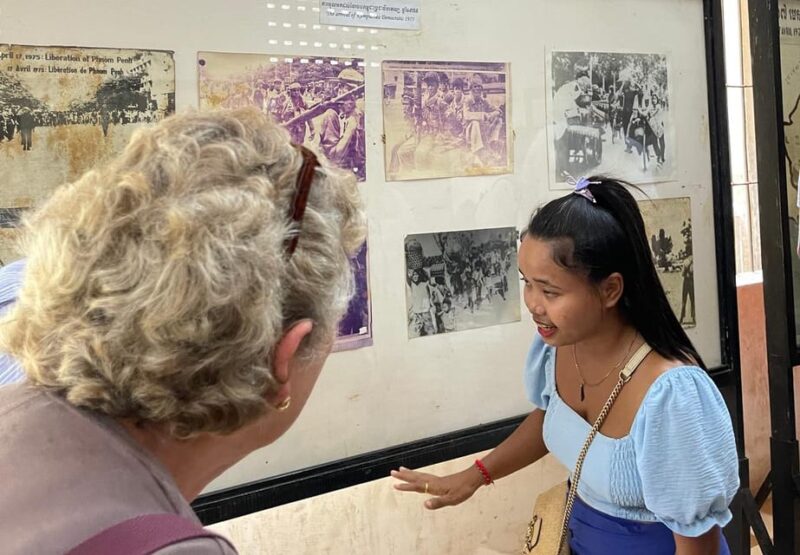
- The Tuol Sleng Genocide Museum, formerly a high school, was transformed into Security Prison 21 (S-21) under the Khmer Rouge regime.
- The Choeung Ek Killing Fields site contains mass graves and a memorial stupa filled with victims’ skulls, honoring those who perished.
- The tour highlights the tragic history of the Khmer Rouge’s atrocities and their impact on Cambodia’s national identity and human rights.
- The preserved artifacts and memorials serve as a sobering reminder of the fragility of civilization and the dangers of unchecked power.
- The tour encourages visitors to reflect on the past and its implications for building a more just and equitable society.
Tour Overview
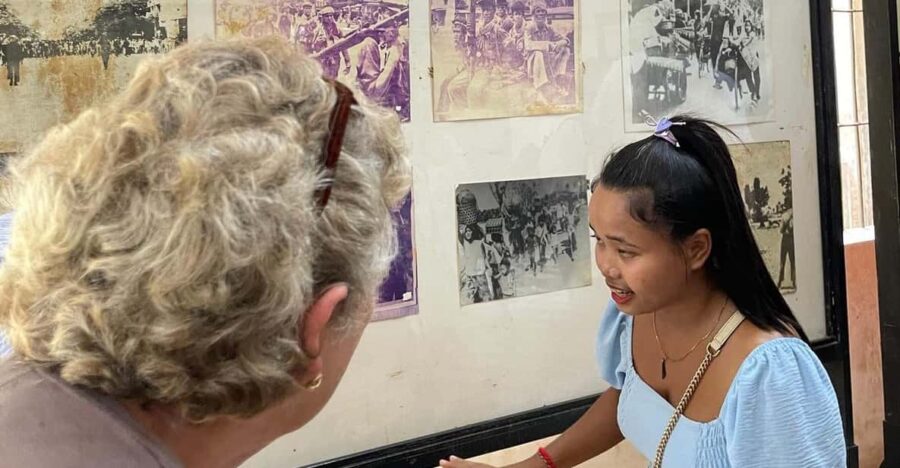
The tour of Phnom Penh’s Genocide Museums focuses on the S21 Prison and the Killing Fields, providing a 3-hour immersive experience.
Priced at $65 per person, the small group tour is limited to 9 participants and led by a live English-speaking guide.
Guests can expect free cancellation up to 24 hours for a full refund, as well as flexible booking with the option to reserve now and pay later.
Transportation is provided via tuk-tuk or van, depending on group size, and complimentary cold water is offered throughout the tour.
Ready for more culture? More museums we feature in Phnom Penh
Itinerary Details
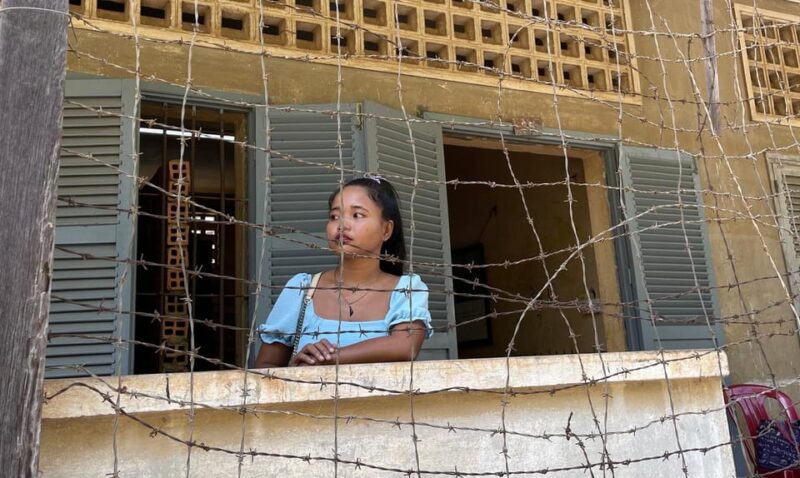
The tour begins with a pickup at the participant’s accommodation in Phnom Penh, either at 8 am or 1 pm.
The first stop is the Tuol Sleng Genocide Museum, where a 1-hour guided tour reveals its history. Originally a high school, it was transformed into Security Prison 21 (S-21) by the Khmer Rouge. Visitors can see the preserved cells, torture devices, and photographs of victims.
The second stop is the Choeung Ek Killing Fields, the site of mass graves and a stupa filled with victims’ skulls, serving as a memorial to those who perished.
Historical Significance
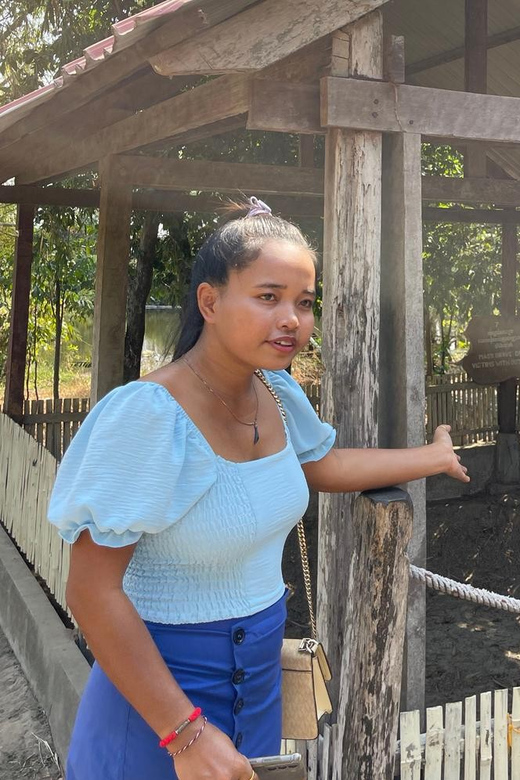
Revealing Cambodia’s tragic past and honoring resilient survivors, the tour underscores the perils of unchecked power and human rights abuses.
The historical significance of this experience lies in the insight it provides into the profound impact of these events on Cambodia’s history and identity.
By exploring the Tuol Sleng Genocide Museum and the Killing Fields, visitors gain a deeper understanding of the Khmer Rouge regime‘s atrocities and the resilience of the Cambodian people.
This tour serves as a powerful reminder of the importance of safeguarding human rights and preventing such horrors from occurring again.
Tour Inclusions
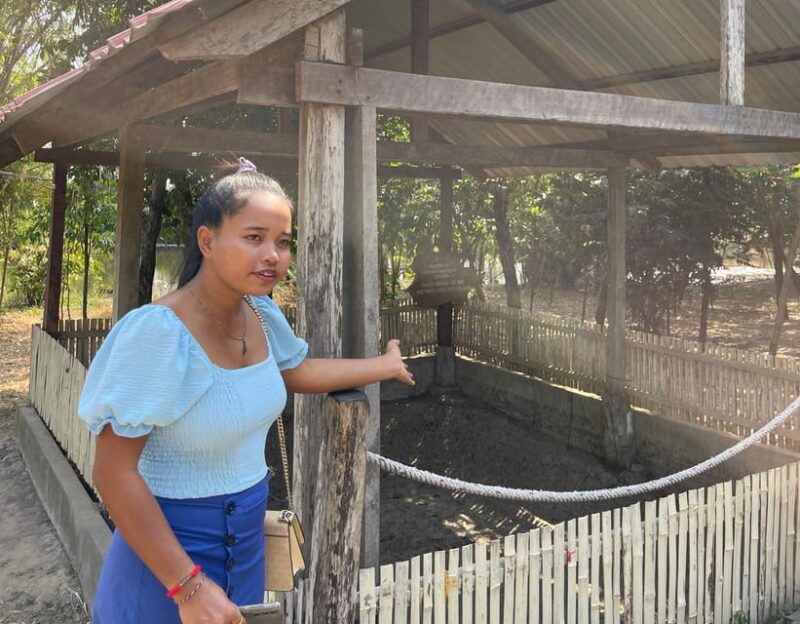
For the tour, an English local guide is included, along with all entry fees. Travelers can expect transportation by TukTuk (for 1-4 participants) or Van (for 5-9 participants). Cold water is provided during the tour, though personal expenses, food, and other items are excluded.
| Inclusions | Exclusions |
|---|---|
| English local guide | Personal expenses |
| All entry fees | Food |
| Transportation | Other items |
| Cold water |
The tour provides a comprehensive and immersive experience, allowing visitors to learn about Cambodia’s tragic past and honor the resilience of survivors.
More Great Thing To Do NearbyBooking Information
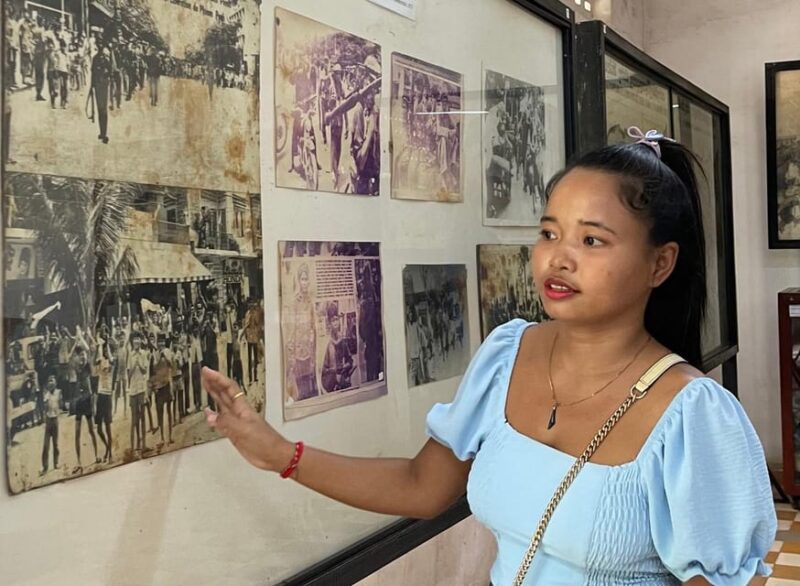
Travelers can check the availability of the tour for specific dates and participant numbers. They must provide their name and address for pickup when booking.
The itinerary is subject to change, but the main stops at the Tuol Sleng Genocide Museum and Choeung Ek (Killing Fields) are guaranteed. The tour includes an English-speaking local guide, all entry fees, transportation by TukTuk or Van, and cold water during the tour.
Personal expenses, food, and other items are excluded. This 3-hour tour offers a powerful and essential experience to understand Cambodia’s tragic past and resilient spirit.
Fascinated by Phnom Penh's past? More historical tours we've covered
Tuol Sleng Genocide Museum
The former Tuol Sleng high school now stands as the Tuol Sleng Genocide Museum, a harrowing reminder of the Khmer Rouge’s brutal Security Prison 21 (S-21).
Visitors are guided through preserved cells, torture devices, and haunting photographs of victims, offering a sobering glimpse into the horrors of the past.
The museum serves as a powerful memorial, honoring the resilience of survivors and highlighting the devastating impact of unchecked power and human rights abuses.
As a key stop on the Phnom Penh genocide tour, the Tuol Sleng Genocide Museum provides invaluable insight into Cambodia’s tragic history and its enduring legacy.
Choeung Ek Killing Fields
After visiting the Tuol Sleng Genocide Museum, the tour proceeds to the Choeung Ek Killing Fields, a somber site that serves as a memorial to the victims of the Khmer Rouge regime.
At this former orchard, over 17,000 people were brutally executed and buried in mass graves. Visitors can see the mass graves and a stupa filled with the skulls of those who perished.
The Killing Fields stand as a powerful reminder of the atrocities committed and the resilience of the Cambodian people in the face of such tragedies.
The site provides a profound and emotional experience for those seeking to understand Cambodia’s history.
Impactful Lessons Learned
Visiting the Tuol Sleng Genocide Museum and Choeung Ek Killing Fields in Phnom Penh imparts several impactful lessons.
These sites highlight the perils of unchecked power and the devastating consequences of human rights abuses. They serve as a somber reminder of the fragility of civilization and the importance of vigilance against totalitarianism.
The preserved artifacts and haunting memorials provide insight into Cambodia’s tragic past, honoring the resilience of survivors and the victims.
These museums offer a profound learning experience, challenging visitors to reflect on the past and consider how to build a more just and equitable future.
Frequently Asked Questions
How Did the Khmer Rouge Justify Their Actions During the Cambodian Genocide?
The Khmer Rouge claimed their brutal actions were necessary to create a classless agrarian society, though in reality, their extreme ideology and totalitarian control led to widespread massacres and the deaths of over 1.5 million Cambodians.
What Happened to the Perpetrators of the Cambodian Genocide?
Many Khmer Rouge leaders were eventually tried and convicted for their crimes. However, some evaded justice, and some committed suicide to avoid accountability for the genocide they perpetrated against the Cambodian people.
How Have the Survivors of the Cambodian Genocide Been Affected Psychologically?
Survivors of the Cambodian genocide have endured profound psychological trauma, grappling with PTSD, depression, and grief. Many struggle to heal and rebuild their lives, yet demonstrate remarkable resilience in the face of immense suffering.
What Measures Have Been Taken to Prevent Future Genocides in Cambodia?
Cambodia has implemented educational programs, human rights initiatives, and memorials to promote reconciliation and prevent future atrocities. The government also works with international organizations to strengthen rule of law and democratic institutions.
How Can Visitors Respect the Somber Atmosphere of the Genocide Museums?
Visitors should be respectful and somber, avoiding disruptive behavior. They should listen attentively to guides, avoid taking selfies, and reflect on the victims’ suffering. Quiet contemplation and sensitivity are key to honoring the victims’ memory.
Sum Up
Visiting Phnom Penh’s genocide museums offers a harrowing yet essential experience. Tourists gain a deeper understanding of the Khmer Rouge’s atrocities and the resilience of the Cambodian people. These sites serve as powerful reminders of the importance of human rights, the fragility of society, and the need to prevent such tragedies from happening again. The lessons learned here resonate profoundly, inspiring visitors to become advocates for justice and peace.
You can check if your dates are available here:More Museum Experiences in Phnom Penh
- Killing Fields & Toul Sleng Genocide Museum Tickets With Tuk Tuk
- Private Half Day Trip to Genocidal Museum & Killing Field
- The Killing Field and Toul Sleng Genocide Museum (S21) Tour
- Royal Palace, S-21 Genocide, National Museum & Killing Field
- Phnom Penh Haft Day Tour Killing Field & Genocide Museum
- Khmer Rouge In Depth: Tuol Sleng Museum & Killing Fields
More Historical Tours in Phnom Penh
More Tour Reviews in Phnom Penh
Not for you? Here's more things to do in Phnom Penh we have recnetly reviewed
- Phnom Penh: 2-Day City Highlights Tour
- 4 Best Dining Experiences In Phnom Penh
- 6 Best 2 Day Tours In Phnom Penh
- 4 Best Dinner Tours In Phnom Penh
- 25 Best Cruises And Boat Tours In Phnom Penh
- 19 Best Food Tours In Phnom Penh
- 20 Best Full-Day Tours In Phnom Penh
- 3 Best 3 Day Tours In Phnom Penh
- 3 Best 4 Day Tours In Phnom Penh
- 2 Best BBQ Experiences In Phnom Penh
- 9 Best Massage And Relaxation Services In Phnom Penh
- 9 Best Motorbike And Scooter Rentals In Phnom Penh
